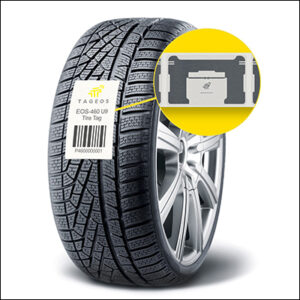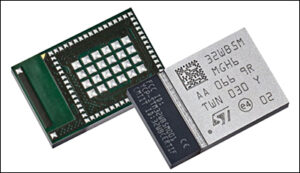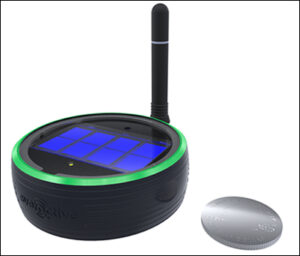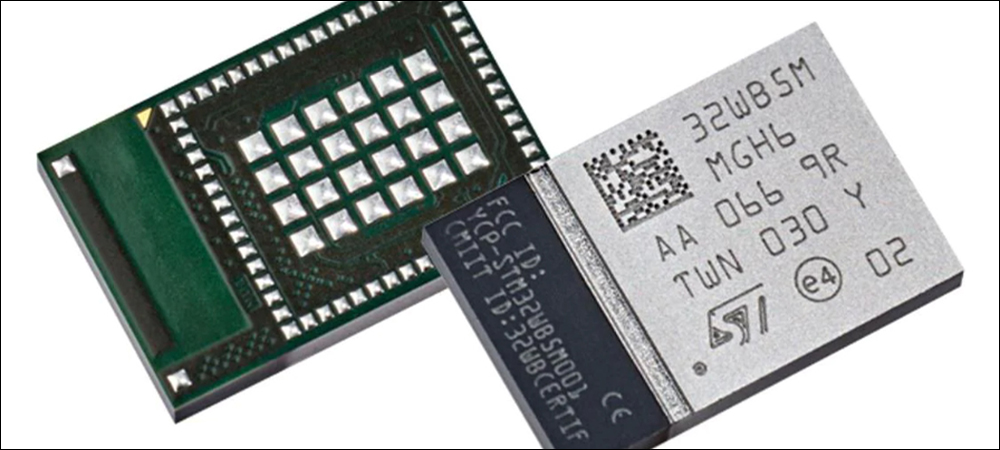- Tageos Intros RFID Inlays for Tire Inventory
- STMicroelectronics Offers Wireless Module with BLE
- OpenSynergy Unveils BLE Stack for Audio Streaming
- Everactive Releases Batteryless IoT Development Kit
- Resource Label Group Acquires MedLit Solutions
- Industry IoT Consortium Publishes New White Paper
Presented here are recent news announcements in the radio frequency identification and Internet of Things industries.
Tageos Intros RFID Inlays for Tire Inventory
 Tageos has announced its EOS-460 U9 RAIN RFID inlays, designed for inventory-control applications for tires and other rubberized items. According to the company, the new products comply with the tire industry’s ARC RFID Lab specification requirements. The EOS-460 U9 inlays, Tageos reports, have a narrow X pitch (antenna length) and maintain required sensitivity in 90- and 270-degree orientations. The X pitch is 75 millimeters (3 inches), while the next smallest size of 80 millimeters (3.1 inches), making the EOS-460 U9 suitable for converting processes.
Tageos has announced its EOS-460 U9 RAIN RFID inlays, designed for inventory-control applications for tires and other rubberized items. According to the company, the new products comply with the tire industry’s ARC RFID Lab specification requirements. The EOS-460 U9 inlays, Tageos reports, have a narrow X pitch (antenna length) and maintain required sensitivity in 90- and 270-degree orientations. The X pitch is 75 millimeters (3 inches), while the next smallest size of 80 millimeters (3.1 inches), making the EOS-460 U9 suitable for converting processes.
The new inlays are intended for both tire trade and manufacturing applications, the company reports, including automotive and aviation, due to their performance on rubber surfaces and their range of high-dielectric materials. They feature NXP Semiconductors‘ UCODE 9 IC, enabling a long read distance and fast inventory tracking of dense RFID tag populations. This chip features a 96-bit Electronic Product Code (EPC), a kill password, a permalock function, self-adjusting impedance and memory integrity safeguards.
The EOS-460 U9 inlays are available in dry, wet and paper-face formats, with the dry format being the most suitable for tire-tagging applications, according to Tageos. “With our new EOS-460 U9 RAIN RFID inlays,” said Chris Reese, the company’s CTO, in a prepared statement, “Tageos has once again proven that we are able to respond quickly and exceptionally well to customer and market demands across a wide range of segments, and to develop market-leading products that meet specific requirements better than the competition.”
STMicroelectronics Offers Wireless Module with BLE
STMicroelectronics, a provider of semiconductors for electronics applications, has introduced a smart wireless module designed to increase industrial productivity while reducing waste and pollution. Conceived for Industry 4.0 applications, this module, known as the STM32WB5MMGH6, uses wireless microcontrollers for such use cases as I-care Group‘s equipment condition monitoring solution.
 The module provides a subsystem for wireless communication using standards such as Bluetooth Low Energy, Zigbee and Thread, and it comes with free protocol stacks, though developers can use other proprietary protocols as well. The module integrates several components, including the antenna and its matching circuitry, along with timing crystals. Pre-certifications for EMC, Bluetooth LE 5.3, Zigbee 3.0 and OpenThread are intended to simplify the testing and product-level approval processes for users.
The module provides a subsystem for wireless communication using standards such as Bluetooth Low Energy, Zigbee and Thread, and it comes with free protocol stacks, though developers can use other proprietary protocols as well. The module integrates several components, including the antenna and its matching circuitry, along with timing crystals. Pre-certifications for EMC, Bluetooth LE 5.3, Zigbee 3.0 and OpenThread are intended to simplify the testing and product-level approval processes for users.
The STM32WB5MMGH6TR is now in production, priced at $6 for orders of 10,000 pieces. It is supported by ST’s 10-year product-longevity commitment, which ensures the long-term availability of parts for industrial applications. The STM32WB55 MCU powering the STM32WB5MMGH6 has an Arm Cortex-M4 core for application-level processing and a Cortex-M0+ dedicated to managing the integrated radio, which safeguards real-time performance in both domains.
The MCU contains a high level of on-chip RAM, according to STMicroelectronics. Use cases include wireless communication and control of devices such as remote sensors, smart door locks, PC accessories (including printers), and infrastructure equipment like network gateways and smart-building controllers. The radio’s multi-protocol technology provides flexibility, the company indicates, and allows device administration and fleet management.
Product designers working with the STM32WB5MMGH6 module can utilize the STM32 microcontroller development ecosystem, which includes free tools like the STM32CubeMX configurator and software like the STM32CubeWB MCU package. This package provides embedded-development resources, including production-ready MISRA C and ISO/TS 16949-compliant hardware abstraction layer (HAL) and low-layer APIs, the FatFS file system, FreeRTOS, communication-protocol stacks and code examples.
OpenSynergy Unveils BLE Stack for Audio Streaming
OpenSynergy has announced its Blue SDK v7 Bluetooth stack, which implements new profiles to enable audio streaming via Bluetooth Low Energy (BLE). A new codec, known as LC3, makes it possible to stream audio via BLE, providing improved audio quality at roughly half the bit rate compared to the traditional Bluetooth audio codec. According to OpenSynergy, synchronized audio streams can be shared across multiple receiving devices via Multi-Stream Audio and Broadcast Audio. Blue SDK v7 is ready for immediate integration.
Multi-stream audio allows for synchronized audio streams between an audio source a device and one or more receiving devices, the company explains. For example, a single smartphone can send an independent stream of the Left channel to one Bluetooth speaker and independent steam of the Right channel to another Bluetooth speaker. Both speakers can then work together as a single system to play stereo audio.
Broadcast Audio enables an audio source device to broadcast one or more audio streams to many receiving devices. This new topology is referred to as audio sharing, which can be used for broadcasting audio within public venues, and for sharing audio from the same source device with friends. For example, an in-car entertainment system can broadcast the same audio to a group of passengers wearing headphones, enabling the driver to avoid distraction or answer a phone call.
New Bluetooth profiles, such as Telephony and Media Audio Profile (TMAP), define interoperable support for both telephony and media audio compared to the Classic Audio profiles, such as A2DP for media streaming, AVRCP for media controls, and HFP for telephony. The new profile architecture for LE Audio consolidates functionality into smaller underlying profiles that can be reused across use cases. Additionally, the company reports, LE Audio and the new LE Dynamic Power Control can reduce power consumption and optimize signal strength.
“LE Audio significantly enhances the user experience of Bluetooth audio streaming by improving audio quality, reducing latency, and adding the ability to easily share audio,” said David Baum, the director of OpenSynergy’s Wireless Technologies Competency Center, in a prepared statement. “Our implementation of LE Audio will continue our legacy of excelling where open-source and consumer-grade Bluetooth stacks fall short. It is a continuation of our commitment to providing the outstanding flexibility, robustness, and interoperability that our users have come to love about Blue SDK.”
Everactive Releases Batteryless IoT Development Kit
Everactive, which produces batteryless Internet of Things (IoT) systems, is releasing its first development kit to allow third-party developers to build their own IoT products without the need for batteries. The company’s self-powered hardware and managed network are built to acquire and provide dense physical-world data, the company reports. This, Everactive explains, allows IoT developers to build scalable, sustainable and data-rich products for their customers.
 The development kit includes two patented Everactive batteryless IoT devices, each with a sensor suite that simultaneously measures temperature, humidity, pressure and triaxial acceleration. Utilizing a low-light indoor photovoltaic harvester as the sole power source, these devices can measure and wirelessly transmit data every 15 seconds. The development kit is intended to help developers better understand and experiment with energy-harvesting technology for IoT applications.
The development kit includes two patented Everactive batteryless IoT devices, each with a sensor suite that simultaneously measures temperature, humidity, pressure and triaxial acceleration. Utilizing a low-light indoor photovoltaic harvester as the sole power source, these devices can measure and wirelessly transmit data every 15 seconds. The development kit is intended to help developers better understand and experiment with energy-harvesting technology for IoT applications.
In the past, Everactive notes, IoT developers have struggled to achieve widespread adoption due to the continued reliance on batteries and inadequate wireless communication options. The finite power available in batteries, as well as their inevitable replacement cycles, forces designers to make tradeoffs between device lifetime, data quality and deployment scale. Similarly, existing wireless options have proven suboptimal in balancing data rate, range and network density.
Everactive leverages energy-efficient semiconductors to continuously operate devices from low levels of micro-renewable harvested energy, without the need for batteries. The company’s Evernet wireless network communicates data at a long range from high-density sensor networks. According to Everactive, delivering data through a managed network simplifies the activation process and improves the speed at which an engineer can experiment. The company is currently accepting orders for development kits and will begin shipping them next month.
Resource Label Group Acquires MedLit Solutions
Resource Label Group, a provider of pressure-sensitive labels, shrink-sleeve, and RFID and Near Field Communication (NFC) technologies, has announced that it has acquired MedLit Solutions, a supplier of pharmaceutical packaging and printing solutions. With locations in Garner, N.C., and Winston, N.J., MedLit offers end solutions for the pharmaceutical, biotech and healthcare industries.
MedLit Solutions offers printing, design, labels and turn-key custom kitting, fulfillment and mailing solutions, as well as multi-dimensional inserts, patient brochures, folding cartons, IFUs, 2D barcoding and digital storefronts. The North Carolina location is ISO-9001- and ISO-15378-certified.
“As an industry leader, our priority is to provide customers the highest quality, innovative solutions to meet their challenging packaging requirements,” said Kevin Grogan, MedLit Solutions’ CEO, in a prepared statement. “The partnership with Resource Label Group will expand our capabilities and improve the buying experience we provide to our customers. We are very excited about the opportunity ahead of us.”
Mike Apperson, Resource Label Group’s president and CEO, added in the statement: “I am proud to welcome the team at MedLit Solutions to the Resource Label Group family. MedLit has an outstanding team of packaging experts focused on providing best-in-class solutions for their customers. Their industry expertise significantly strengthens our offering and position in the growing pharmaceutical segment.”
Industry IoT Consortium Publishes New White Paper
The Industry IoT Consortium (IIC) has published a white paper titled “Automated Onboarding and Device Provisioning Best Practices.” Intended for system integrators, service providers, and users implementing industrial IoT solutions, the paper offers security best practices and standards for automated device onboarding and provisioning.
“Endpoint security protection is a challenging area for the industrial IoT,” said Keao Caindec, the chair of the IIC’s Security Working Group, in a prepared statement. “Devices deployed in the field may not have the necessary computing power or hardware compared to their counterparts sitting in the central office. Organizations must vet any equipment added to the network when onboarded through device or equipment provisioning.” Caindec is also the CEO and a principal analyst at Farallon Technology Group.
Internet of Things devices are deployed on the remote edge of the service area, IIC explains, and are vulnerable due to their visibility, as well as their limited hardware and software capabilities. The devices require services to ensure end-to-end security protection, in order to mitigate risks and defend against malicious attacks.
“Security-by-design is the best and most straightforward approach to secure a system because organizations can embed security at the beginning of the concept, architecture, and design process,” added John Fornehed, an expert on IoT technologies at Ericsson and a lead author of the IIC whitepaper, in the prepared statement. “We hope this paper will serve as a guide in the area of life cycle management of secure identities, especially provisioning from device production through owner change and into service, all while doing this at scale.”


